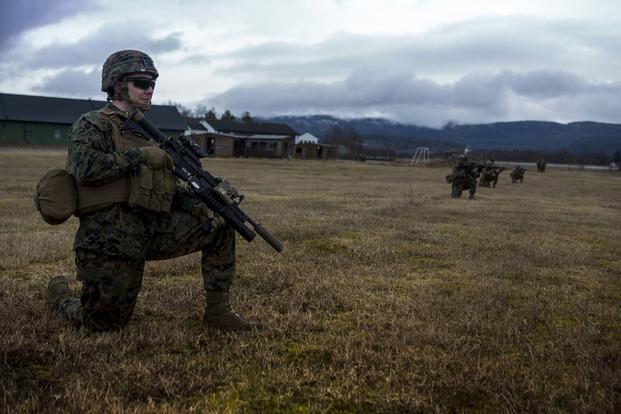VAERNES GARRISON, Norway -- When Bravo Company, 1st Battalion, 2nd Marines, arrived here in January, they weren't just beginning a brand-new rotational deployment. They were also the first Marine Corps infantry unit to deploy with suppressors on every individual service weapon.
And three months into using suppressed weapons in every exercise and live-fire training event, Marines who spoke with Military.com say they never want to go back.
In November, Military.com broke the news that the Corps was embarking on a proof-of-concept effort to silence every weapon in an infantry battalion, from M4 service rifles to .50 caliber machine guns.
In an interview at the time, 2nd Marine Division commanding officer Maj. Gen. John Love said the suppressors, also called silencers, were already changing the way Marines operated in early testing and evaluation.
"It used to be a squad would be dispersed out over maybe 100 yards, so the squad leader couldn't really communicate with the members at the far end because of all the noise of the weapons," he said. "Now they can actually just communicate, and be able to command and control, and effectively direct those fires."
Troops with Marine Corps Rotational Force-Europe agree.
They've used suppressed M4s and M27 infantry automatic rifles in Arctic cold-weather training environments and most recently at a joint live-fire attack event in Romania. During that event, three platoons from Bravo Company operated alongside one from the battalion's Weapons Company that didn't have suppressed rifles. The difference was marked, said Capt. Mark Edgar, commanding officer of Bravo Company.
"It took us back to remembering what it was like not to be suppressed, when you see people trying to communicate," Edgar said. "For guys in charge of other Marines, being able to talk is a big way that we fight. The suppressed weapons have helped that a lot."
For Staff Sgt. Troy Hauck, a platoon sergeant with Bravo Company's Weapons Platoon, not having to worry about ear protection when firing his rifle is a nice bonus. But a potentially bigger boon is the element of surprise that comes with a suppressed weapon.
"Just doing some of the training attacks that we've done on this deployment has been good," he said. "I'm on one side of the hill and [part of the company is] on the other side of the hill, and I can't hear them firing their weapons. It's pretty nice, real stealthy."
There are a few practical hassles that come with using the Marine Corps-issued SureFire suppressors.
They get very hot when used, and can burn skin and clothing if not handled with care. They must be cleaned properly in order to stay effective. They add a pound or so of weight to the rifle, and the current model occasionally comes loose from the rifle muzzle, said Staff Sgt. Nelson Acevedo, platoon sergeant for Bravo's 3rd Platoon.
Nonetheless, he said, the advantages of using the suppressors are clear. While the individual suppressors might add weight to the rifles, their use allows team leaders to stop carrying radios and extra radio batteries, making them ultimately lighter.
"Normally, going into a deliberate attack or something like that, we would want to have it be feasible and optimal to have team leaders equipped with radios, just because normally from the firing, it's going to negate the ability to laterally communicate by your mouth," he said. "With the suppressors now, there's no need for that, because they can communicate."
Acevedo also said he has noticed that getting rid of the radios has allowed the Marines to focus on the action in front of them, helping them to avoid "tunnel vision."
"If they can make the suppressor overall just a little lighter, that would be good," he said. "But overall, I'd say we're about at a 75-percent solution."
Whether that solution will be implemented for the full Marine Corps is up to the commandant and other senior service brass. Edgar said the unit has been providing feedback on using the suppressors since it began its predeployment workup in October, routing reports and insights through the 1/2 battalion gunner, or weapons officer.
Two other companies have been issued suppressors as the evaluation phase continues: Lima Company, 3rd Battalion, 6th Marines, which deployed aboard the 24th Marine Expeditionary Unit in March; and Lima Company, 3rd Battalion, 8th Marines, which deployed to Japan as part of the unit deployment program in February.
The 2nd Marine Division gunner, Chief Warrant Officer 5 Christian Wade, said in November that he was still working to equip the Marines' M249 light machine gun and M240G medium machine gun with suppressors, with plans to silence the .50 caliber heavy machine gun last.
Wade estimated equipping an infantry battalion with suppressors would cost about $700,000, a price tag that might give decision-makers pause.
Asked about the status of evaluation at the end of March, Commandant Gen. Robert Neller told Military.com he is worried about both cost and weight when evaluating the possibility of issuing suppressors to infantrymen.
"The cost to kit out an infantry Marine used to be a couple thousand bucks; now it's like $7,500. I've got to store this stuff, they've got to carry this stuff. I'm trying to make the load lighter, not heavier," he said. "But it's a tool ... every action has a side-effect, but we'll work through all that."
-- Hope Hodge Seck can be reached at hope.seck@military.com. Follow her on Twitter at@HopeSeck






























